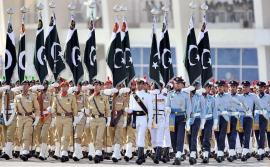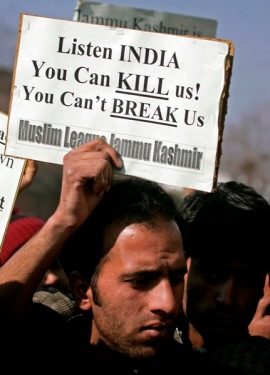
Rick Rozoff:
 With the Strategic Arms Reduction Treaty (START) on the Reduction and Limitation of Strategic Offensive Arms expiring last December 5 and its successor held up almost three months in large part because of U.S. missile shield provocations in recent weeks, the North Atlantic Treaty Organization is forging ahead with the formulation and implementation of a new Strategic Concept.
With the Strategic Arms Reduction Treaty (START) on the Reduction and Limitation of Strategic Offensive Arms expiring last December 5 and its successor held up almost three months in large part because of U.S. missile shield provocations in recent weeks, the North Atlantic Treaty Organization is forging ahead with the formulation and implementation of a new Strategic Concept.
On February 5 Russia unveiled its new military doctrine, which identified further NATO expansion eastward to its frontier and American and NATO interceptor missile deployments on and near its borders as the “main external threats of war.” [1]
On February 23 NATO held its fourth seminar on the new – 21st century – Strategic Concept decided upon at the sixtieth anniversary summit in April of 2009 in Strasbourg, France and Kehl, Germany. After previous meetings in Luxembourg, Slovenia and Norway, the final – and far most important – meeting was held in Washington, DC. Entitled Strategic Concept Seminar on Transformation and Capabilities, it was conducted at the National Defense University in the nation’s capital.
The Strategic Concept endorses expansion of the bloc deeper into the Balkans and the former Soviet Union, broadening global partnerships outside the Euro-Atlantic zone and consolidating an interceptor missile system to cover all of Europe as a joint U.S. and NATO project.
Russian concerns and NATO designs are at complete loggerheads, which accounts for among other problems a new START agreement remaining in limbo. And for Russia’s new military doctrine.
The results of the four seminars, masked as deliberative proceedings and even public information forums when in fact all important matters were decided years in advance, will be presented to NATO Secretary General Anders Fogh Rasmussen on May 1 and formally adopted at the NATO summit in Lisbon, Portugal this November.
The meetings that matter, those in the American capital where the White House and the Pentagon are situated, were presided over by former U.S. secretary of state Madeleine Albright and former chief executive officer of Royal Dutch Shell Jeroen van der Veer and their Group of Experts, alternatively Wise Men. The speakers at the Washington seminar included the U.S. foreign policy triumvirate of Secretary of Defense Robert Gates, Secretary of State Hillary Clinton and National Security Adviser James Jones, the last NATO’s Supreme Allied Commander from 2003-2006. Other talks were given by the same principals on the preceding evening.
The U.S. permanent representative to NATO, Ivo Daalder, and Alliance chief Rasmussen also gave presentations.
Gates demanded the world’s only true military bloc and certainly the sole one currently involved in a war “uphold the long legacy that has made NATO the most successful military alliance in history.” [2]
All the American speakers laid particular emphasis on NATO’s Article 5, in effect a mutual assistance provision for armed conflicts.
Robert Gates: “Few would have imagined that the first invocation of Article 5 in the alliance’s history would follow an attack on the United States homeland by a non-state entity based in a nation far beyond NATO’s traditional borders….”
“[T]he Strategic Concept must be clear that Article 5 means what it says: an attack on one is an attack on all. The concept also must go further to strengthen Article 5’s credibility with a firm commitment to enhance deterrence through appropriate contingency planning, military exercises, and force development.”
Hillary Clinton: “I want to reaffirm as strongly as I can the United States’ commitment to honor Article 5 of the NATO treaty. No Ally – or adversary – should ever question our determination on this point. It is the bedrock of the Alliance and an obligation that time will not erode.” [3]
Ivo Daalder: “Article 5 of the North Atlantic Treaty, which says that an attack against one is an attack against all, remains the bedrock of the alliance. And in order to have that Article 5 operate effectively in the world that we live in today, we need the deployability of forces, we need the ability for forces to move from different places across territory, we need to be prepared through exercising and planning to show and ensure that NATO is prepared to confront the threats that we face….” [4]
James Jones went even further in stating “NATO must be more lean, agile, and flexible to effectively address the security challenges before it. NATO must move beyond its doctrine of static defense of the 20th Century to become a more proactive Alliance for the modern era.”
“NATO must be prepared to address, deny, and deter the full spectrum of threats, whether emanating from within Europe, at NATO’s boundaries, or far beyond NATO’s borders.” [5]
NATO and American officials were equally unequivocal on the deployment of global interceptor missile facilities in Europe and beyond. NATO chief Anders Fogh Rasmussen said “Clearly, the development of a common Missile Defence capability will be more efficient and more cost effective if it is developed in common.” [6]
More specifically, he said that “missile defence has become a strategic imperative. To my mind, missile defence makes the most sense in an Alliance context. That way, you get forward-based sensors and infrastructure. Allied defence systems can fill the gaps in the US system’s coverage.” [7]
Daalder linked that project with NATO’s Article 5:
In his words, it is necessary “to make territorial missile defense a mission of this alliance, a mission to defend against a new kind of armed attack, that which arrives on ballistic missiles, whether these weapons come from Iran and hit Western Europe or North Korea and towards North America. In both instances, they would be a responsibility for Article 5 to be dealt with.”
Specifically mentioning the “120-some-thousand troops” from fifty nations serving under NATO command in Afghanistan and ongoing NATO naval operations in the Gulf of Aden and the Horn of Africa, he added: “Those are the kinds of operations that we are engaged in, that we are likely to continue to engage in, some of which will follow under Article 5. A defense against ballistic missile attack – even those of ballistic missiles come from very far if they attack NATO territory – would be an Article 5 contingency.”
Daalder came to his current post as U.S. ambassador to NATO from being Senior Fellow at the Brookings Institution and before that director for European Affairs on the National Security Council from 1995-1996, where he was responsible for the Clinton administration’s Bosnia policy.
He was an avid supporter of and advocate for the wars against Yugoslavia in 1999 – co-authoring a 2000 book titled Winning Ugly: NATO’s War to Save Kosovo – against Iraq in 2003 and against Afghanistan from 2001 to the present.
In his years at Brookings he co-authored a number of articles with James Goldgeier, a Senior Fellow at the Council on Foreign Relations, including a 2006 piece called “For global security, expand the alliance” which stated “since the challenges NATO faces are global, its membership should be as well.”
The authors added “NATO must become larger and more global by admitting any democratic state that is willing and able to contribute to the fulfillment of the alliance’s new responsibilities.
“NATO’s ability to bring together countries with similar values and interests to combat global problems is constrained by the exclusively trans-Atlantic character of its membership. Other democratic countries share NATO’s values and many common interests – including Australia, Brazil, Japan, India, New Zealand, South Africa and South Korea – and all of them can greatly contribute to NATO’s efforts by providing additional military forces or logistical support to respond to global threats and needs.” [8]
In the same year Daalder and Goldgeier wrote an article for Foreign Affairs, the publication of the Council on Foreign Relations, entitled “Global NATO.” In contents included the contention that “the North Atlantic Treaty Organization has gone global” and that its alleged “forward defense often requires a global military reach.” [9]
The new Strategic Concept, in addition to codifying a 21st century and expeditionary NATO (the terms are those of Alliance officials and advocates), will fully launch global NATO, the world’s first international military axis.
The project promoted by Daalder and his colleagues since the early 1990s is to be brought to fruition. He was given his post last year to assist in achieving that objective.
In the tendentious journalism he practiced in the pages of major U.S. dailies and journals while senior fellow at the Brookings Institution from 1998-2009 Daalder frequently criticised the ineffectuality of the United Nations, and his program for a global NATO – his exact term, recall – is meant not to supplement but to supplant the UN. [10]
Madeleine Albright, who delivered the opening and closing remarks at the February 23 Strategic Concept seminar, has similarly derogated the role of the UN; she who was U.S. ambassador to the organization from 1993 to 1997 when she led the successful effort to depose UN Secretary-General Boutros Boutros-Ghali in 1997 after conspiring behind his back with Kofi Annan to obtain UN authorization for NATO’s bombing of Bosnian Serb positions in August and September of 1995. (The following month Annan was appointed UN special envoy to NATO.)
In speaking of “our vision for a revitalized Alliance for the 21st century,” Hillary Clinton celebrated Albright’s efforts throughout the post-Cold War period in her address in Washington on February 22: “She helped bring some of the countries represented here tonight into NATO in the late 1990s – an effort that many questioned at the time but which I believe has proven to be a major success. She played a central role in developing NATO’s last Strategic Concept eleven years ago.”
The vision of what NATO is to become in the new millennium was officially disclosed by Secretary General Anders Fogh Rasmussen on February 7 at the annual Munich Security Conference. He unabashedly called for a global NATO.
Ahead of the Strategic Concept meeting in Washington, he urged that “NATO can be the place where views, concerns and best practices on security are shared by NATO’s global partners. And where … we might work out how to tackle global challenges together.” [11]
His view was seconded by Madeleine Albright, who said “I think we are talking about how we can have some coordinating mechanism for all the various organizations that exist in the world.” Raising a rhetorical question as to “which organization can make the biggest difference,” she answered it with “While I am a great admirer of the United Nations, I know what it can and cannot do.” [12]
A Russian news source responded eleven days later by revealing “NATO’s new strategy authorizing the alliance to use force in any part of the globe arouses deep concern in Moscow.
“Foreign Minister Sergei Lavrov has said this strategy contradicts the United Nations’ Charter.”
Russia’s Lavrov warned that with the Alliance’s new Strategic Concept “NATO’s sphere of interests may cover the entire world.” [13]
That is precisely what the new doctrine and policy is designed to effect and what Rasmussen, Albright, et al. bluntly state its intention to be. The United Nations and international law will take a back seat to global NATO.
NATO “is working on a new military strategy which will let the alliance…use force globally,” of which Russia Foreign Minister Lavrov said “It does not fully comply with the UN Charter, and, of course, raises our concerns.” [14]
Not only does the Western military bloc’s plans to undermine, supersede and ultimately scrap the entire post-World War II international diplomatic and security order “not fully comply with the UN Charter,” it is a direct attack on it.
The new concept also reiterates and intensifies the complete militarization of Europe, the retention of U.S. nuclear arms and the stationing of missile shield components there and the deployment of the continent’s troops to war zones abroad. 35 of 41 European nations have deployed troops to Afghanistan on NATO’s behest, for example. [15]
It also advocates the right of the North Atlantic military bloc to intervene anywhere in the world and is increasingly reviving discussion of activating its Article 5 provision for confrontation with Russia in Europe and the South Caucasus.
Earlier this month Belgian Prime Minister Belgian Yves Leterme stated that his nation and Germany, Luxembourg, the Netherlands and Norway would issue a joint declaration urging consideration of the removal of U.S. nuclear weapons in Europe. Belgium, Germany and the Netherlands are among five NATO countries housing the warheads, the others being Italy and Turkey. [16]
Nevertheless NATO’s position is to support the continued basing of American nuclear weapons, and the bloc will defer to Washington’s 2010 Nuclear Posture Review, scheduled to be submitted to Congress last December but delayed for several months.
NATO is the Pentagon’s nuclear Trojan horse in Europe.
After the founding of the North Atlantic Treaty Organization in April of 1949 – four months before the Soviet Union successfully tested its first atomic bomb – the U.S. began to station nuclear weapons in Europe, as many as 7,300 by the early 1970s. [17]
The Pentagon retains as many as 350 nuclear weapons in the five nations mentioned above, a full twenty years after the end of the Cold War.
At the Strategic Concept seminar on February 23 in Washington Ivo Daalder repeated the sixty-year NATO position on nuclear weapons in stating, “We need to continue to rely on a deterrence based on a mix of conventional and nuclear forces.”
He also linked three integral components of NATO’s now global strategy – the threat to employ nuclear weapons, a worldwide interceptor missile system and the bloc’s Article 5 war clause – in asserting that “we need, in the new environment, to make territorial missile defense a mission of this alliance, a mission to defend against a new kind of armed attack, that which arrives on ballistic missiles, whether these weapons come from Iran and hit Western Europe or North Korea and towards North America. In both instances, they would be a responsibility for Article 5 to be dealt with.”
To underscore the point – that NATO would marshal the combined military might of its 28 member states in Europe and North America in alleged defense of any member requesting it – he added, “A defense against ballistic missile attack – even those of ballistic missiles come from very far if they attack NATO territory – would be an Article 5 contingency.”
“We would like the alliance to embrace the notion that the territorial defense of our – of – that territorial missile defense is a mission of NATO and therefore ought to be a fundamental part of what NATO does on a day-to-day basis. Whether that’s in the Strategic Concept or is a separate decision at the Lisbon summit is less important. Article 5 is going to be in the Strategic Concept. Ballistic missiles that are directed at the territory of a NATO state would be an armed attack and therefore fall under the definition of Article 5.
“We believe NATO should be in the business of missile defense. The United States has offered its new approach to missile defense as its U.S.-funded contribution to a NATO system. And we hope that by Lisbon [the NATO summit in November], the entire alliance will embrace this as a mission and we move forward together in defending against the threats that are out there in the 21st century.”
Defense Secretary Gates spoke in the same vein: “The threat from rogue nations is real – in particular Iran, which is focusing its efforts on short-and-medium-range missiles that could strike most of Europe. Last year, the Obama administration announced a new plan for missile defense in Europe – a phased, adaptive approach that will give us real capabilities in a shorter period of time than the previous plan. We consider this a U.S.-funded contribution to NATO missile defense, which is critical to the collective-defense mission….”
Collective defense, sometimes deemed collective self-defense, are the NATO codewords for activating Article 5 and ordering all members to respond militarily to a threat – real or fancied – to one or more members.
Clinton followed suit in stating “Missile defense, we believe, will make us safer because, clearly, we see a threat. We see a threat that is emanating from the Middle East and we see a threat that can only be addressed in the spirit of collective defense.”
Targeting the same countries earlier identified by Daalder (two of the three so-called axis of evil nations identified as such by former president George W. Bush), she said, “nuclear proliferation and the development of more sophisticated missiles in countries such as North Korea and Iran are reviving the specter of an interstate nuclear attack. So how do we in NATO do our part to ensure that such weapons never are unleashed on the world?”
In no manner does Iran raise the “specter of an interstate nuclear attack” and Clinton knew that. But it is the pretext required by the U.S. and NATO to base interceptor missile sites along Russia’s western borders from the Baltic Sea to the Black Sea.
The excuse needed to support Clinton’s demand that, more than twenty years since the dismantling of the Berlin Wall, NATO members still “need to invest in deterrence, nuclear deterrence as well as missile defense….”
The U.S. nuclear shield, linked with NATO’s Article 5, is being extended from Europe to Asia, the Middle East and ultimately the entire world. Global nuclear NATO.
In keeping with the conference held on NATO’s new Strategic Concept in London last October 1, hosted by Lloyd’s of London, in which the bloc’s Secretary General Rasmussen identified no less than seventeen nominal threats – all of them non-military in nature and all of them without geographical limitations – that NATO was prepared to respond to, [18] the Washington conference also highlighted the boundless and timeless mandate that NATO was arrogating to itself.
Rasmussen’s speech on February 23 included these observations:
“We must face new challenges. Terrorism, proliferation, cyber security or even climate change will oblige us to seek new ways of operating.
“As we deploy in operations with over 40 participating countries – Allies as well as partners – we have to move beyond a multinational force to become a truly unified force – a force where information and capabilities are shared among all to the benefit of all, and to get the job done.
“I have decided to establish a new division at NATO Headquarters to deal with new threats and challenges. Naturally Allied Command Transformation will be a key partner for this new division, which will become operational after the summer.” [19]
The previous evening Rasmussen spoke at Georgetown University in Washington, DC and elaborated on the Alliance’s Article 5 in practice rather than just in theory:
“The problems of the 21st century can only be solved multilaterally. And there is no stronger, more effective framework for that cooperation than NATO. But did you know that, on September 12th, all of America’s Allies in NATO declared that they considered this attack on America as an attack on them as well? Did you know that NATO sent aircraft to patrol the skies here in the United States? Did you know that all NATO countries put their ports and airfields at US disposal for the operation into Afghanistan? Or that most of them sent Special Forces, alongside US soldiers, in the initial military response?
“44 countries have soldiers in Afghanistan, under NATO command. Sharing the risks, the costs and the burdens with the United States. The non-US members make up 40% of the total number of forces. They also take 40% of the casualties.” [20]
He also indicated which nation NATO may next invoke its collective military assistance clause against: Russia. Unnamed but not needing to be in the context he was discussing.
“Our NATO Ally Estonia suffered a few years ago from a sustained, directed cyber attack that shut down a lot of essential services.
Read more of this post






















































































Recent Comments